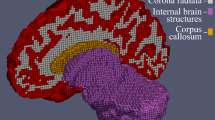Abstract
In brain surgery procedures, such as deep brain stimulation, drug-resistant epilepsy and tumour surgery, the patient is intentionally awakened to map functional neural bases via electrophysiological assessment. This assessment can involve patient’s body movements; thus, increasing the mechanical load on the head-restraint systems used for keeping the skull still during the surgery. The loads exchanged between the head and the restraining device can potentially result into skin and bone damage. The aim of this work is to assess such loads for laying down the requirements of a surgical robotics system for dynamic head movements compensation by fast moving arms and by an active restraint able to damp such actions. A Mayfield® head clamp was tracked and instrumented with strain gages (SGs). SG locations were chosen according to finite element analyses. During an actual brain surgery, displacements and strains were measured and clustered according to events that generated them. Loads were inferred from strain data. The greatest force components were exerted vertically (median 5.5 N, maximum 151.87 N) with frequencies up to 1.5 Hz. Maximum measured displacement and velocity were 9 mm and 60 mm/s, with frequencies up to 2.8 Hz. The analysis of loads and displacements allowed to identify the surgery steps causing maximal loads on the head-restraint device.








Similar content being viewed by others
References
Chao L, Chen K (1997) Shape optimal design and force sensitivity evaluation of six-axis force sensors. Sens Actuators A 63:105–112
D’Amico M, Ferrigno G (1990) Technique for the evaluation of derivatives from noisy biomechanical displacement data using a model-based bandwidth-selection procedure. Med Biol Eng Comput 28:407–415
De Lorenzo D, De Momi E, Dyagilev I, Manganelli R, Formaglio A, Prattichizzo D, Shoham M, Ferrigno G (2011) Force feedback in a piezoelectric linear actuator for neurosurgery. Int J Med Robot Comput Assisted Surg 7:268–275
Donaldson N, Munih M, Perkins T, Wood D (1999) Apparatus to measure simultaneously 14 isometric leg joint moments. Part 1: design and calibration of six-axis transducers for the forces and moments at the ankle. Med Biol Eng Comput 37:137–147
Dreier JD, Williams B, Mangar D, Camporesi EM (2009) Patients selection in awake neurosurgery. HSR Proc Intensive Care Cardiovasc Anesth 30:19–27
Duffau H (2005) Lessons from brain mapping in surgery for low-grade glioma: insights into associations between tumour and brain plasticity. Lancet Neurol 4:476–486
Ferrigno G, Baroni G, Casolo F, De Momi E, Gini G, Matteucci M, Pedrocchi A (2011) Medical robotics. Pulse IEEE 2:55–61
Hemm S, Werdell K (2010) Stereotactic implantation of deep brain stimulation electrodes: a review of technical systems, methods and emerging tools. Med Biol Eng Comput 48:611–624
Lee M, Rezai AR, Chou J (1994) Depressed skull fractures in children secondary to skull clamp fixation devices. Pediatr Neurosurg 21:174–7; discussion 178
Lee MJ, Lin EL (2010) The use of the three-pronged Mayfield head clamp resulting in an intracranial epidural hematoma in an adult patient. Eur Spine J 19(Suppl 2):S187–S189
Liker MA, Won DS, Rao VY, Hua SE (2008) Deep brain stimulation: an evolving technology. Proc IEEE 96:1129–1141
Liu SA, Tzo HL (2002) A novel six-component force sensor of good measurement isotropy and sensitivities. Sens Actuators A 100:223–230
Malosio, M, Negri SP, Pedrocchi N, Vicentini F, Cardinale F, Tosatti LM (2012) The kinematic architecture of the active headframe: a new head support for awake brain surgery. In: Proceedings of the 34th annual international conference of the engineering in medicine and biology society, San Diego, USA
Mandir AS, Rowland LH, Dougherty PM, Lenz FA (1997) Microelectrode recording and stimulation techniques during stereotactic procedures in the thalamus and pallidum. Adv Neurol 74:159–165
Olivier PE, Du Toit DE (2008) Isokinetic neck strength profile of senior elite rugby union players. J Sci Med Sport 11:96–105
Puangmali P, Althoefer K, Seneviratne LD, Murphy D, Dasgupta P (2008) State-of-the-art in force and tactile sensing for minimally invasive surgery. Sens J IEEE 8:371–381
Rezasoltani A, Ylinen J, Bakhtiary AH, Norozi M, Montazeri M (2008) Cervical muscle strength measurement is dependent on the location of thoracic support. Br J Sports Med 42:379–382
Rozet I, Vavilala MS (2007) Risks and benefits of patient positioning during neurosurgical care. Anesthesiol Clin 25:631–653
Seng KY, Lee Peter VS, Lam PM (2002) Neck muscle strength across the sagittal and coronal planes: an isometric study. Clin Biomech (Bristol, Avon) 17:545–547
Serramito-Garcia R, Arcos-Algaba A, Santin-Amo JM, Garcia-Allut A, Bandin-Dieguez FJ, Gelabert-Gonzalez M (2009) Epidural haematoma due to an headrest in an adult. Neurocirugia (Astur) 20:567–570
Szelenyi A, Bello L, Duffau H, Fava E, Feigl GC, Galanda M, Neuloh G, Signorelli F, Sala F, Workgroup for Intraoperative Management in Low-Grade Glioma Surgery within the European Low-Grade Glioma Network (2010) Intraoperative electrical stimulation in awake craniotomy: methodological aspects of current practice. Neurosurg Focus 28:E7
Trejos AL, Patel RV, Naish MD (2010) Force sensing and its application in minimally invasive surgery and therapy: a survey. Proc Inst Mech Eng Part C J Mech Eng Sci 224:1435–1454
Vasavada AN, Li S, Delp SL (2001) Three-dimensional isometric strength of neck muscles in humans. Spine (Phila Pa 1976) 26:1904–1909
Wang Z, Peng C, Zheng X, Wang P, Wang G (1997) Force measurement on fracture site with external fixation. Med Biol Eng Comput 35:289–290
Acknowledgments
This work was supported by the EU Project Grant ACTIVE FP7-ICT-2009-6-270460. Authors would like to thank Elisa Beretta for her precious help during the experimental setup preparation.
Author information
Authors and Affiliations
Corresponding author
Rights and permissions
About this article
Cite this article
De Lorenzo, D., De Momi, E., Conti, L. et al. Intraoperative forces and moments analysis on patient head clamp during awake brain surgery. Med Biol Eng Comput 51, 331–341 (2013). https://doi.org/10.1007/s11517-012-1002-9
Received:
Accepted:
Published:
Issue Date:
DOI: https://doi.org/10.1007/s11517-012-1002-9




